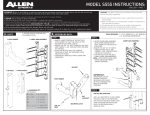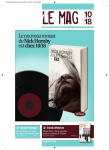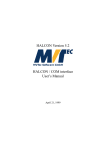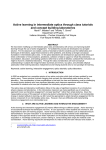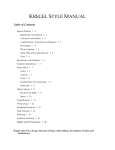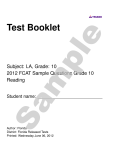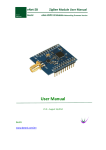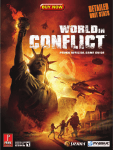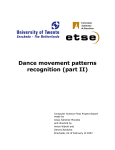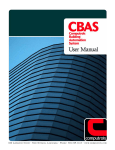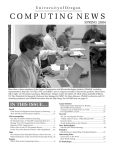Download File - Center for Student Achievement
Transcript
Test ID #7394297 2015-16 ATI AzMERIT ELA 09 Gr. CBAS #1 Comprehensive Blueprint Assessment Series Instructions: It is time to begin. The scores of this test will help teachers plan lessons. Carefully, read each item in the test booklet. Select the best answer: A, B, C, or D. Use a pencil. Mark your answer on the ANSWER SHEET. Fill in the bubble next to your answer choice. Make sure the bubble is completely colored. Erase any extra pencil lines or changed answers. You may write on the test booklet unless your teacher gave you scratch paper. Review and check your answers after you have finished the test. ©Assessment Technology, Incorporated 2015 All rights reserved. No part of this document may be reproduced or transmitted in any form or by any means, electronic or mechanical, including photocopy, recording, or any information storage and retrieval system, without permission from the publisher. Printed in the U.S.A. 1 2015-16 ATI AzMERIT ELA 09 Gr. CBAS #1 Read each question carefully. "An Early Missile Guidance System" In December of 1941, the United States of America entered World War II. During the next four years, the nation would be called upon to make great personal sacrifices and to arrive at innovative solutions to life and death problems on a global scale. The nation’s creative energies were harnessed as they had never been before. Some of the ideas and plans that were implemented during that period were brilliant. Others were discarded as impractical. Some of the initiatives displayed a rare and brash boldness typical of the American spirit. The story you are about to read is one of these. Early in the war the nation’s military began to think seriously about the development of a guided missile system of the type routinely used in military engagements today. The potential benefits were clear. An unmanned missile system would be cost-efficient, since people would not have to be trained to fly it. If we could guide an unmanned missile toward an enemy target, the likelihood of hitting the target would be increased. American lives would be preserved and enemy strength would be weakened. Also, our military knew that the Germans were working on an unmanned missile system. Thus, they urgently sought a solution to the guidance problem. A potential solution came from an unlikely source: Dr. B. F. Skinner, a nationally prominent psychologist. Dr. Skinner made an appointment to demonstrate his system to a room full of highlevel military decision makers. The demonstration was very successful. The guidance system was small and performed with high levels of accuracy on test targets. Then, one of the enthusiastic military observers asked for an explanation of how the system worked. Dr. Skinner responded by opening the case housing the system. Inside was a pigeon that had been trained to keep a pointer on a moving target. The pigeon controlled the pointer by pecking at a bar that determined the pointer’s position. Dr. Skinner controlled the pigeon’s behavior by the use of rewards. When the bird was performing the task successfully, small food pellets were automatically dispensed. This encouraged the bird to perform its assigned task as successfully as possible. As you might guess, Dr. Skinner’s solution was a bit too bold for adoption by the military. Nonetheless, in my view, it was an innovative solution to what at the time was a difficult problem to solve. Assessment Technology, Inc. 2005 2 2015-16 ATI AzMERIT ELA 09 Gr. CBAS #1 AZ-RI.9.2 Key Ideas and Details: Determine a central idea of a text and analyze its development over the course of the text, including how it emerges and is shaped and refined by specific details; provide an objective summary of the text. 1) from “An Early Missile Guidance System” Read the summary about Dr. Skinner’s role in developing an unmanned missile system. Dr. Skinner, a prominent psychologist of the time, developed a possible solution for an unmanned missile system during World War II. He demonstrated his unmanned missile guidance system to an audience of high-level military personnel. Then, he showed the personnel how the system worked. A pigeon inside the case housing the system had been taught to keep a pointer on a moving target. When it performed well, it received small food pellets. After learning how Dr. Skinner’s missile system operated, the military was not interested in developing the idea. Which detail from the text is most important to add to this summary? A) It wasn’t often that psychologists found solutions for military problems. B) An unmanned missile system would preserve American lives and weaken the enemy. C) Dr. Skinner’s system was small and performed to a high degree of accuracy. D) During World War II, the military wanted to develop an unmanned missile system. 3 2015-16 ATI AzMERIT ELA 09 Gr. CBAS #1 AZ-RI.9.1 Key Ideas and Details: Cite strong and thorough textual evidence to support analysis of what the text says explicitly as well as inferences drawn from the text. 2) from “An Early Missile Guidance System” What does the topic sentence of the last paragraph tell you about Dr. Skinner’s plan? A) It had many successful elements. B) It had a high rate of accuracy. C) It was controlled by a pigeon. D) It was not adopted by the military. AZ-RI.9.5 Craft and Structure: Analyze in detail how an author’s ideas or claims are developed and refined by particular sentences, paragraphs, or larger portions of a text (e.g., a section or chapter). 3) from "An Early Missile Guidance System" Which best supports the claim that the nation's thinkers came up with bold and creative solutions to the problems posed by World War II? "During the next four years, the nation would be called upon to make great A) personal sacrifices and to arrive at innovative solutions to life and death problems on a global scale." "The nation’s creative energies were harnessed as they had never been before. Some of the ideas and plans that were implemented during that B) period were brilliant.... Some of the initiatives displayed a rare and brash boldness typical of the American spirit." "Also, our military knew that the Germans were working on an unmanned C) missile system. Thus, they urgently sought a solution to the guidance problem." "Then, one of the enthusiastic military observers asked for an explanation of how the system worked. Dr. Skinner responded by opening the case D) housing the system. Inside was a pigeon that had been trained to keep a pointer on a moving target." 4 2015-16 ATI AzMERIT ELA 09 Gr. CBAS #1 AZ-RI.9.5 Craft and Structure: Analyze in detail how an author’s ideas or claims are developed and refined by particular sentences, paragraphs, or larger portions of a text (e.g., a section or chapter). 4) from “An Early Missile Guidance System” Which sentence from the text supports the author’s statement that Dr. Skinner’s demonstration was successful? A) “A potential solution came from an unlikely source: Dr. B. F. Skinner, a nationally prominent psychologist.” B) “As you might guess, Dr. Skinner’s solution was a bit too bold for adoption by the military.” C) “The guidance system was small and performed with high levels of accuracy on test targets.” D) “When the bird was performing the task successfully, small food pellets were automatically dispensed.” AZ-RI.9.2 Key Ideas and Details: Determine a central idea of a text and analyze its development over the course of the text, including how it emerges and is shaped and refined by specific details; provide an objective summary of the text. 5) from “An Early Missile Guidance System” Which best states the main idea of this text? A) Although he did not share it with the public, B.F. Skinner developed a new and different plan for a missile guidance system. B) Although it ultimately failed to work, B.F. Skinner developed a new and different plan for a missile guidance system. C) Although it was not implemented, B.F. Skinner developed a new and different plan for a missile guidance system. D) Although it was too expensive to implement, B. F. Skinner developed a new and different plan for a missile guidance system. 5 2015-16 ATI AzMERIT ELA 09 Gr. CBAS #1 AZ-RI.9.1 Key Ideas and Details: Cite strong and thorough textual evidence to support analysis of what the text says explicitly as well as inferences drawn from the text. 6) from "An Early Missile Guidance System" For what reason did the military not adopt Dr. Skinner's guidance system? A) It relied upon a pigeon. B) It was too complex to operate easily. C) It performed at low levels of accuracy. D) It was too large to operate easily. “Ringing in the New Year” Father Time is always marching forward. As he advances, Father Time takes us with him into a new year every 365 days (or 366 days at the end of a leap year). There are an infinite number of ways to commemorate this annual event. Some people like to go out for an expensive dinner and reflect quietly on the year. Others prefer to attend wild parties at friends’ houses, laughing and dancing the evening away. Still others think that the best way to spend New Year’s Eve is to ignore it, getting to bed far before the fireworks of midnight. To each his own, but there is one New Year’s Eve event that everyone should experience at least once: reveling in Times Square. New Year’s Eve in Times Square has history. The first rooftop celebration occurred in 1904, when The New York Times produced the party to inaugurate their headquarters and celebrate the renaming of Longacre Square to Times Square. The tradition where a giant ball, now made of crystal, was lowered slowly down a flagpole at midnight started three years later. Standing in Times Square on New Year’s Eve, one can feel a sense of continuity and tradition. People have gathered in Times Square for New Year’s Eve during world wars, blizzards, even a scant few months after the attacks of September 11, 2001. Year after year, they’ve cheered and sung “Auld Lang Syne,” honoring the past and turning an optimistic eye to the future. To be a part of one of these celebrations is to glimpse the strength and joy of humanity. New Year’s Eve in Times Square is not generally a somber occasion. In fact, you have never seen a party like this one! Over a million people flock to Times Square each year, some in fancy dress, many in costumes. Companies give out party favors ranging from pom-poms and balloons to wristbands with bells and bags filled with souvenir confetti. Music blasts from a wireless surround-sound system, and parts of the celebration are shown on gigantic television screens. This is a party, and people act accordingly: you can expect to chat and dance with people you’ve never seen before or will again, and 6 2015-16 ATI AzMERIT ELA 09 Gr. CBAS #1 you can expect to smile often as you experience how friendly New Yorkers can be. Of course, spending an evening surrounded by one million of your closest friends is hectic. In fact, it could be downright exhausting. However, a million people are but a drop in the bucket of the world’s population of over 6 billion. Though New Year’s Eve in Times Square may seem uncommonly popular, the events of December 31 are ones that most watch from home. If you become a veteran of New Year’s Eve in Times Square, you can serve as an ambassador to those who have never experienced it. You’ll have stories to tell that everyone will want to hear. And you’ll keep the tradition alive. Assessment Technology, Inc. 2004 AZ-RI.9.4 Craft and Structure: Determine the meaning of words and phrases as they are used in a text, including figurative, connotative, and technical meanings; analyze the cumulative impact of specific word choices on meaning and tone (e.g., how the language of a court opinion differs from that of a newspaper). 7) from "Ringing in the New Year" Read the paragraph. "New Year’s Eve in Times Square has history. The first rooftop celebration occurred in 1904, when The New York Times produced the party to inaugurate their headquarters and celebrate the renaming of Longacre Square to Times Square. The tradition where a giant Ball was lowered started three years later. Standing in Times Square on New Year’s Eve, one can feel a sense of continuity and tradition. People have gathered in Times Square for New Year’s Eve during world wars, blizzards, even a scant few months after the attacks of September 11, 2001. Year after year, they’ve cheered and sung “Auld Lang Syne,” honoring the past and turning an optimistic eye to the future. To be a part of one of these celebrations is to glimpse the strength and joy of humanity." Based on the word choice in this paragraph, who is the author’s intended audience? A) people who enjoy staying at home and watching television B) people who lived through World Wars I and II C) people who remember when Times Square was named Longacre Square D) people who are interested in traditions 7 2015-16 ATI AzMERIT ELA 09 Gr. CBAS #1 AZ-RI.9.8 Integration of Knowledge and Ideas: Delineate and evaluate the argument and specific claims in a text, assessing whether the reasoning is valid and the evidence is relevant and sufficient; identify false statements and fallacious reasoning. 8) from “Ringing in the New Year” Which sentence from the text is an example of overgeneralization? A) “In fact, you have never seen a party like this one!” B) “But a million people is but a drop in the bucket of the world’s population of over 6 billion.” C) “New Year’s Eve in Times Square is not generally a somber occasion.” D) “Some people like to go out for an expensive dinner…” 8 2015-16 ATI AzMERIT ELA 09 Gr. CBAS #1 AZ-RI.9.4 Craft and Structure: Determine the meaning of words and phrases as they are used in a text, including figurative, connotative, and technical meanings; analyze the cumulative impact of specific word choices on meaning and tone (e.g., how the language of a court opinion differs from that of a newspaper). 9) from "Ringing in the New Year" Read the paragraph. "New Year’s Eve in Times Square is not generally a somber occasion. In fact, you have never seen a party like this one! Over a million people flock to Times Square each year, some in fancy dress, many in costumes. Companies give out party favors ranging from pom-poms and balloons to wristbands with bells and bags filled with souvenir confetti. Music blasts from a wireless surround-sound system, and parts of the celebration are shown on gigantic television screens. This is a party, and people act accordingly: you can expect to chat and dance with people you’ve never seen before or will again, and you can expect to smile often as you experience how friendly New Yorkers can be." Based on the word choice in this paragraph, who is the author’s intended audience? A) elderly people B) young adults C) small children D) New Yorkers 9 2015-16 ATI AzMERIT ELA 09 Gr. CBAS #1 AZ-RI.9.3 Key Ideas and Details: Analyze how the author unfolds an analysis or series of ideas or events, including the order in which the points are made, how they are introduced and developed, and the connections that are drawn between them. 10) from "Ringing in the New Year" Which best describes how the second paragraph of the text is organized? A) pro and con B) compare and contrast C) classification schemes D) chronological order AZ-RI.9.8 Integration of Knowledge and Ideas: Delineate and evaluate the argument and specific claims in a text, assessing whether the reasoning is valid and the evidence is relevant and sufficient; identify false statements and fallacious reasoning. 11) from “Ringing in the New Year” Read the excerpt. “If you become a veteran of New Year’s Eve in Times Square, you can serve as an ambassador to those who have never experienced it. You’ll have stories to tell that everyone will want to hear. And you’ll keep the tradition alive.” Why is this argument fallacious? A) The author assumes that the celebration is a tradition. B) The author assumes that everyone enjoys hearing about New Year’s Eve celebrations. C) The author assumes that attending the celebration makes you a veteran. D) The author assumes that you will have ambassadors who want to hear your stories. 10 2015-16 ATI AzMERIT ELA 09 Gr. CBAS #1 AZ-RI.9.2 Key Ideas and Details: Determine a central idea of a text and analyze its development over the course of the text, including how it emerges and is shaped and refined by specific details; provide an objective summary of the text. 12) from "Ringing in the New Year" Which most accurately describes how the author develops the text's main idea? A) Through detailed descriptions, the author teaches readers how to recreate New Year's traditions of Times Square in their own hometowns. Through vivid description, the author tries to convince the reader that B) visiting Times Square is one of the most exciting ways to spend New Year's Eve. Through sharing personal experience, the author tries to make readers feel C) that spending New Year's Eve in Times Square is an unforgettable experience. Through an explanation of the history of the celebration, the author tries to D) convince readers they are missing out on something important if they do not visit Times Square. On October 16, 1859, John Brown led a force of 21 men on a raid of the armory at Harpers Ferry, Virginia. Brown planned to distribute captured weapons to slaves, who he hoped would rise up against their owners. The raid failed, and Brown was captured and put on trial for treason against the state of Virginia. He was found guilty on November 2 and sentenced to die by hanging. The raid on Harpers Ferry was widely reported, with newspapers in both the North and South condemning Brown's actions. A few days before Brown's trial concluded, Henry David Thoreau read the following essay in defense of Brown to a group of citizens in Concord, Massachusetts. Thoreau repeated this performance several times before Brown was hung on December 2. "A Plea for John Brown" by Henry David Thoreau (excerpted and slightly adapted) I trust that you will pardon me for being here. I do not wish to force my thoughts upon you, but I feel forced myself. Little as I know of Captain Brown, I would fain do my part to correct the tone and the statements of the newspapers, and of my countrymen generally, respecting his character and actions. It costs us nothing to be just. We can at least express our sympathy with, and admiration of, him and his companions, and that is what I now propose to do. 11 2015-16 ATI AzMERIT ELA 09 Gr. CBAS #1 I should say that he was an old-fashioned man in respect for the Constitution, and his faith in the permanence of this Union. Slavery he deemed to be wholly opposed to these, and he was its determined foe. He was like the best of those who stood at Concord Bridge once, on Lexington Common, and on Bunker Hill, only he was firmer and higher principled than any that I have chanced to hear of as there. It was no abolition lecturer that converted him. Ethan Allen and [John] Stark [both men fought in the Revolutionary War], with whom he may in some respects be compared, were rangers in a lower and less important field. They could bravely face their country's foes, but he had the courage to face his country herself, when she was in the wrong. *** I have noticed the cold-blooded way in which newspaper writers and men generally speak of Brown’s raid on Harpers Ferry, as if an ordinary malefactor had been caught, and were about to be hung. It turns what sweetness I have to gall, to hear, or hear of, the remarks of some of my neighbors. I hear one ask, "What will he gain by it?" as if he expected to fill his pockets by this enterprise. Such a one has no idea of gain but in this worldly sense. If it does not lead to a new pair of boots, it must be a failure. "But he won't gain anything by it." Well, no, I don't suppose he could get four-and-sixpence a day for being hung; but then he stands a chance to save a considerable part of his soul. No doubt you can get more in your market for a quart of milk than for a quart of blood, but that is not the market that heroes carry their blood to. Such people as my neighbor do not know that like the seed is the fruit, and that, in the moral world, when good seed is planted, good fruit is inevitable, and does not depend on our watering and cultivating; that when you plant, or bury, a hero in his field, a crop of heroes is sure to spring up. This is a seed of such force and vitality, that it does not ask our leave to germinate. Many cannot conceive of a man who is actuated by higher motives than they are. Accordingly they pronounce this man insane, for they know that they could never act as he does, as long as they are themselves. As for the herd of newspapers and magazines, I do not chance to know an editor in the country who will deliberately print anything which he knows will ultimately and permanently reduce the number of his subscribers. They do not believe that it would be expedient. How then can they print truth? If we do not say pleasant things, they argue, nobody will attend to us. And so they do like some travelling auctioneers, who sing an obscene song, in order to draw a crowd around them. Editors, obliged to get their sentences ready for the morning edition, and accustomed to look at everything by the twilight of politics, express no admiration, nor true sorrow even, but call these men "deluded fanatics," "mistaken men," "insane," or "crazed." It suggests what a sane set of editors we are blessed with, who know very well on which side their bread is 12 2015-16 ATI AzMERIT ELA 09 Gr. CBAS #1 buttered, at least. *** This event advertises me that there is such a fact as death—the possibility of a man's dying. It seems as if no man had ever died in America before; for in order to die you must first have lived. Brown and his men, in teaching us how to die, have at the same time taught us how to live. It is the best news that America has ever heard. It has already quickened the feeble pulse of the North, and infused more and more generous blood into her veins and heart, than any number of years of what is called commercial and political prosperity could. Who is it whose safety requires that Captain Brown be hung? If you do not wish it, say so distinctly. While these things are being done, beauty stands veiled and music is a screeching lie. Think of him—of his rare qualities! Such a man as it takes ages to make, and ages to understand; a man such as the sun may not rise upon again in this benighted land. To whose making went the costliest material, the finest adamant [a legendary, unbreakable material]; sent to be the redeemer of those in captivity; and the only use to which you can put him is to hang him at the end of a rope! You who pretend to care for Christ crucified, consider what you are about to do to him who offered himself to be the savior of four millions of men. I am here to plead his cause with you. I plead not for his life, but for his character—his immortal life; and so it becomes your cause wholly, and is not his in the least. I foresee the time when the painter will paint a scene; the poet will sing it; the historian record it; and, with the Landing of the Pilgrims and the Declaration of Independence, it will be the ornament of some future national gallery, when at least the present form of slavery shall be no more here. We shall then be at liberty to weep for Captain Brown. Then, and not till then, we will take our revenge. Thoreau, Henry David. "A Plea for Captain John Brown." Concord, Mass. 30 Oct. 1859. Reading. 13 2015-16 ATI AzMERIT ELA 09 Gr. CBAS #1 AZ-RI.9.9 Integration of Knowledge and Ideas: Analyze seminal U.S. documents of historical and literary significance (e.g., Washington’s Farewell Address, the Gettysburg Address, Roosevelt’s Four Freedoms speech, King’s “Letter from Birmingham Jail”), including how they address related themes and concepts. 13) from "A Plea for John Brown" Read the quotation. "We shall then be at liberty to weep for Captain Brown." What does Thoreau mean? A) Brown will be viewed in a positive light once slavery has been outlawed. B) People who mourn Brown hide their feelings for fear of being charged with treason. C) If people spent time researching Brown and his actions, they would mourn him. D) Former slaves are among the only people who freely express admiration for Brown. AZ-RI.9.6 Craft and Structure: Determine an author’s point of view or purpose in a text and analyze how an author uses rhetoric to advance that point of view or purpose. 14) from "A Plea for John Brown" Which best describes Thoreau's main purpose? A) to encourage his audience to read the accounts of Brown's raid on Harpers Ferry B) to convince his listeners that capital punishment is unjust and dehumanizing C) to persuade jurors to find Brown innocent of the crime of treason D) to convince his listeners that Brown is actually a hero 14 2015-16 ATI AzMERIT ELA 09 Gr. CBAS #1 AZ-RI.9.1 Key Ideas and Details: Cite strong and thorough textual evidence to support analysis of what the text says explicitly as well as inferences drawn from the text. 15) from "A Plea for John Brown" Read the quotation. "You who pretend to care for Christ crucified, consider what you are about to do to him who offered himself to be the savior of four millions of men." Who are the "four millions of men"? A) churchgoers B) slaves C) soldiers D) slaveholders AZ-RI.9.9 Integration of Knowledge and Ideas: Analyze seminal U.S. documents of historical and literary significance (e.g., Washington’s Farewell Address, the Gettysburg Address, Roosevelt’s Four Freedoms speech, King’s “Letter from Birmingham Jail”), including how they address related themes and concepts. 16) from "A Plea for John Brown" Read the quotation. "It was no abolition lecturer that converted him." What does this indicate about Brown? A) He was not concerned about slavery when he was a student. B) His opposition to slavery is a fundamental part of his character. C) His recent religious conversion led him to oppose slavery. D) He is more knowledgeable about slavery than most abolitionists. 15 2015-16 ATI AzMERIT ELA 09 Gr. CBAS #1 AZ-RI.9.6 Craft and Structure: Determine an author’s point of view or purpose in a text and analyze how an author uses rhetoric to advance that point of view or purpose. 17) from "A Plea for John Brown" Which quotation demonstrates the use of sarcasm for rhetorical effect? A) "It turns what sweetness I have to gall, to hear, or hear of, the remarks of some of my neighbors." B) "It suggests what a sane set of editors we are blessed with, who know very well on which side their bread is buttered, at least." C) "It seems as if no man had ever died in America before; for in order to die you must first have lived." D) "It is the best news that America has ever heard." AZ-L.9.4a Vocabulary Acquisition and Use: Use context (e.g., the overall meaning of a sentence, paragraph, or text; a word’s position or function in a sentence) as a clue to the meaning of a word or phrase. 18) Read the sentence. Turning on the lights allayed my little sister’s fear that there was a monster in her bedroom. Based on the context of the sentence, what is the meaning of "allayed"? A) passed on B) lessened C) continued D) heightened The Sheridans are having a lavish garden party at their large estate, and Laura is busy preparing the flowers and advising her sisters on their clothing when the family gets the bad news that one of the poor villagers who lives in a cottage at the bottom of the hill has been killed. Laura’s first instinct is to cancel the party, but her objections are overruled. Read on to find out what happens when the party is over. Spelling and grammar reflect the author's original style. 16 2015-16 ATI AzMERIT ELA 09 Gr. CBAS #1 “The Garden Party” by Katherine Mansfield (excerpted) "All over, all over, thank heaven," said Mrs. Sheridan. "Round up the others, Laura. Let's go and have some fresh coffee. I'm exhausted. Yes, it's been very successful. But oh, these parties, these parties! Why will you children insist on giving parties!" And they all of them sat down in the deserted marquee. "Have a sandwich, daddy dear." "Thanks." Mr. Sheridan took a bite and the sandwich was gone. He took another. "I suppose you didn't hear of a beastly accident that happened to-day?" he said. "My dear," said Mrs. Sheridan, holding up her hand, "we did. It nearly ruined the party. Laura insisted we should put it off." "Oh, mother!" Laura didn't want to be teased about it. "It was a horrible affair all the same," said Mr. Sheridan. "The chap was married too. Lived just below in the lane, and leaves a wife and half a dozen kiddies, so they say." An awkward little silence fell. Mrs. Sheridan fidgeted with her cup. Really, it was very tactless of father…. Suddenly she looked up. There on the table were all those sandwiches, cakes, puffs, all uneaten, all going to be wasted. She had one of her brilliant ideas. "I know," she said. "Let's make up a basket. Let's send that poor creature some of this perfectly good food. At any rate, it will be the greatest treat for the children. Don't you agree? And she's sure to have neighbours calling in and so on. What a point to have it all ready prepared. Laura!" She jumped up. "Get me the big basket out of the stairs cupboard." "But, mother, do you really think it's a good idea?" said Laura. Again, how curious, she seemed to be different from them all. To take scraps from their party. Would the poor woman really like that? "Of course! What's the matter with you to-day? An hour or two ago you were insisting on us being sympathetic, and now—" Oh well! Laura ran for the basket. It was filled, it was heaped by her mother. "Take it yourself, darling," said she. "Run down just as you are. No, wait, take the arum 17 2015-16 ATI AzMERIT ELA 09 Gr. CBAS #1 lilies too. People of that class are so impressed by arum lilies." "The stems will ruin her lace frock," said practical Jose. So they would. Just in time. "Only the basket, then." It was just growing dusky as Laura shut their garden gates. A big dog ran by like a shadow. The road gleamed white, and down below in the hollow the little cottages were in deep shade. How quiet it seemed after the afternoon. Here she was going down the hill to somewhere where a man lay dead, and she couldn't realize it. Why couldn't she? She stopped a minute. And it seemed to her that kisses, voices, tinkling spoons, laughter, the smell of crushed grass were somehow inside her. She had no room for anything else. How strange! She looked up at the pale sky, and all she thought was, "Yes, it was the most successful party." Now the broad road was crossed. The lane began, smoky and dark. Women in shawls and men's tweed caps hurried by. Men hung over the palings; the children played in the doorways. A low hum came from the mean little cottages. In some of them there was a flicker of light, and a shadow, crab-like, moved across the window. Laura bent her head and hurried on. She wished now she had put on a coat. How her frock shone! And the big hat with the velvet streamer - if only it was another hat! Were the people looking at her? They must be. It was a mistake to have come; she knew all along it was a mistake. Should she go back even now? No, too late. This was the house. It must be. A dark knot of people stood outside. Beside the gate an old, old woman with a crutch sat in a chair, watching. She had her feet on a newspaper. The voices stopped as Laura drew near. The group parted. It was as though she was expected, as though they had known she was coming here. Laura was terribly nervous. Tossing the velvet ribbon over her shoulder, she said to a woman standing by, "Is this Mrs. Scott's house?" and the woman, smiling queerly, said, "It is, my lass." Oh, to be away from this! She actually said, "Help me, God," as she walked up the tiny path and knocked. To be away from those staring eyes, or to be covered up in anything, one of those women's shawls even. I'll just leave the basket and go, she decided. I shan't even wait for it to be emptied. Then the door opened. A little woman in black showed in the gloom. Laura said, "Are you Mrs. Scott?" But to her horror the woman answered, "Walk in please, miss," and she was shut in the passage. "No," said Laura, "I don't want to come in. I only want to leave this basket. Mother sent—" 18 2015-16 ATI AzMERIT ELA 09 Gr. CBAS #1 The little woman in the gloomy passage seemed not to have heard her. "Step this way, please, miss," she said in an oily voice, and Laura followed her. She found herself in a wretched little low kitchen, lighted by a smoky lamp. There was a woman sitting before the fire. "Em," said the little creature who had let her in. "Em! It's a young lady." She turned to Laura. She said meaningly, "I'm 'er sister, miss. You'll excuse 'er, won't you?" "Oh, but of course!" said Laura. "Please, please don't disturb her. I - I only want to leave—" But at that moment the woman at the fire turned round. Her face, puffed up, red, with swollen eyes and swollen lips, looked terrible. She seemed as though she couldn't understand why Laura was there. What did it mean? Why was this stranger standing in the kitchen with a basket? What was it all about? And the poor face puckered up again. "All right, my dear," said the other. "I'll thenk the young lady." And again she began, "You'll excuse her, miss, I'm sure," and her face, swollen too, tried an oily smile. Laura only wanted to get out, to get away. She was back in the passage. The door opened. She walked straight through into the bedroom, where the dead man was lying. "You'd like a look at 'im, wouldn't you?" said Em's sister, and she brushed past Laura over to the bed. "Don't be afraid, my lass," - and now her voice sounded fond and sly, and fondly she drew down the sheet—"'e looks a picture. There's nothing to show. Come along, my dear." Laura came. There lay a young man, fast asleep - sleeping so soundly, so deeply, that he was far, far away from them both. Oh, so remote, so peaceful. He was dreaming. Never wake him up again. His head was sunk in the pillow, his eyes were closed; they were blind under the closed eyelids. He was given up to his dream. What did garden-parties and baskets and lace frocks matter to him? He was far from all those things. He was wonderful, beautiful. While they were laughing and while the band was playing, this marvel had come to the lane. Happy ... happy ... All is well, said that sleeping face. This is just as it should be. I am content. But all the same you had to cry, and she couldn't go out of the room without saying something to him. Laura gave a loud childish sob. "Forgive my hat," she said. 19 2015-16 ATI AzMERIT ELA 09 Gr. CBAS #1 And this time she didn't wait for Em's sister. She found her way out of the door, down the path, past all those dark people. At the corner of the lane she met Laurie. He stepped out of the shadow. "Is that you, Laura?" "Yes." "Mother was getting anxious. Was it all right?" "Yes, quite. Oh, Laurie!" She took his arm, she pressed up against him. "I say, you're not crying, are you?" asked her brother. Laura shook her head. She was. Laurie put his arm round her shoulder. "Don't cry," he said in his warm, loving voice. "Was it awful?" "No," sobbed Laura. "It was simply marvellous. But Laurie—" She stopped, she looked at her brother. "Isn't life," she stammered, "isn't life—" But what life was she couldn't explain. No matter. He quite understood. "Isn't it, darling?" said Laurie. Mansfield, Katherine. "The Garden Party." The Garden Party and other stories. London: Constable, 1922. Print. AZ-RL.9.1 Key Ideas and Details: Cite strong and thorough textual evidence to support analysis of what the text says explicitly as well as inferences drawn from the text. 19) from "The Garden Party" What can you conclude about Mrs. Scott, the dead man's widow? A) She is upset that Laura is inside of her home. B) She is in shock because of her husband's death. C) She is grateful for the gifts that Laura has brought. D) She is unhappy with her sister for interfering. 20 2015-16 ATI AzMERIT ELA 09 Gr. CBAS #1 AZ-RL.9.3 Key Ideas and Details: Analyze how complex characters (e.g., those with multiple or conflicting motivations) develop over the course of a text, interact with other characters, and advance the plot or develop the theme. 20) from "The Garden Party" Read the excerpt. "'Take it yourself, darling,' said she. 'Run down just as you are. No, wait, take the arum lilies too. People of that class are so impressed by arum lilies.'" What does the dialogue reveal about Mrs. Sheridan? A) She does not want to go to the village by herself. B) She feels superior to the lower class villagers. C) She wants to get rid of the arum lilies. D) She wants Laura to feel more sympathetic. AZ-RL.9.1 Key Ideas and Details: Cite strong and thorough textual evidence to support analysis of what the text says explicitly as well as inferences drawn from the text. 21) from "The Garden Party" Which quotation best supports the following thesis statement? Mansfield uses Laura's character to illustrate the development of a conscience in those of the upper class. A) "Here she was going down the hill to somewhere where a man lay dead, and she couldn't realize it." B) "She actually said, 'Help me, God,' as she walked up the tiny path and knocked." C) "I'll just leave the basket and go, she decided." D) "'Forgive my hat,' she said." 21 2015-16 ATI AzMERIT ELA 09 Gr. CBAS #1 AZ-RL.9.2 Key Ideas and Details: Determine a theme or central idea of a text and analyze in detail its development over the course of the text, including how it emerges and is shaped and refined by specific details; provide an objective summary of the text. 22) from "The Garden Party" Which best describes how Mansfield develops a theme of the story? A) She uses imagery to show how privilege shelters people from the reality of death. B) She uses dialogue to reveal the resentment that the disadvantaged feel for the wealthy. C) She uses the basket as a symbol of independence and the rejection of charity. D) She uses descriptive language to illustrate the crippling effects of poverty and hopelessness. AZ-RL.9.5 Craft and Structure: Analyze how an author’s choices concerning how to structure a text, order events within it (e.g., parallel plots), and manipulate time (e.g., pacing, flashbacks) create such effects as mystery, tension, or surprise. 23) from "The Garden Party" The ordering of which two events serves to increase Laura's anxiety about the values she grew up with? A) Laura encounters the dead man after attending a party. B) Laurie is waiting for Laura after she drops off the basket of food. C) Mrs. Sheridan tells Laura to take the lilies; then Jose says they will ruin Laura's smock. D) Laura is shown the dead man; then she runs out of the cottage without saying goodbye. 22 2015-16 ATI AzMERIT ELA 09 Gr. CBAS #1 AZ-RL.9.3 Key Ideas and Details: Analyze how complex characters (e.g., those with multiple or conflicting motivations) develop over the course of a text, interact with other characters, and advance the plot or develop the theme. 24) from "The Garden Party" Which event allows Laura to arrive at her revelation at the end of the story? A) Em cannot speak when Laura arrives. B) Em's sister shows Laura the dead man. C) Laurie tells her that her mother is worried. D) Laurie comforts her and tells her not to cry. AZ-RL.9.2 Key Ideas and Details: Determine a theme or central idea of a text and analyze in detail its development over the course of the text, including how it emerges and is shaped and refined by specific details; provide an objective summary of the text. 25) from "The Garden Party" Which best expresses a theme of this story? A) People are not always grateful for gifts. B) Life's deeper mysteries cannot be explained. C) The wealthy should give all they can to the less fortunate. D) Good intentions do not always lead to positive outcomes. "The Darling" by Anton Chekhov (excerpted and slightly adapted) Olenka, the "darling" of this story, is a woman who is unlucky in love: illnesses take the life of first one and then another husband, and the married veterinary surgeon she falls in love with after becoming a widow for the second time abandons her. *** Now she was absolutely alone. She got thinner and plainer, and when people met her in 23 2015-16 ATI AzMERIT ELA 09 Gr. CBAS #1 the street they did not look at her as they used to, and did not smile; evidently her best years were over and left behind, and now a new sort of life had begun for her, which did not bear thinking about. She looked into her yard without interest, thought of nothing, wished for nothing, and afterwards, when night came on she went to bed and dreamed of her empty yard. And what was worst of all, she had no opinions of any sort. She saw the objects about her and understood what she saw, but could not form any opinion about them, and did not know what to talk about. And how awful it is not to have any opinions! One sees a bottle, for instance, or the rain, or a peasant driving in his cart, but what the bottle is for, or the rain, or the peasant, and what is the meaning of it, one can't say, and could not even for a thousand rubles. When she had Kukin, or Pustovalov [her former husbands], or the veterinary surgeon, Olenka could explain everything, and give her opinion about anything you like, but now there was the same emptiness in her brain and in her heart as there was in her yard outside. And it was as harsh and as bitter as wormwood in the mouth. How rapidly time passes! Olenka's house grew dingy, the roof got rusty, the shed sank on one side, and the whole yard was overgrown. Olenka herself had grown plain and elderly; in summer she sat in the porch, and her soul, as before, was empty and dreary and full of bitterness. The black kitten, Briska, rubbed against her and purred softly, but Olenka was not touched by these feline caresses. That was not what she needed. She wanted a love that would absorb her whole being, her whole soul and reason—that would give her ideas and an object in life, and would warm her old blood. One hot July day, towards evening, just as the cattle were being driven away, and the whole yard was full of dust, someone suddenly knocked at the gate. Olenka went to open it herself and was dumbfounded when she looked out: she saw the veterinary surgeon, grey-headed, and dressed as a civilian. She suddenly remembered everything. She could not help crying and letting her head fall on his breast without uttering a word, and in the violence of her feeling she did not notice how they both walked into the house and sat down to tea. "My dear Vladimir Platonitch! What fate has brought you?" she muttered, trembling with joy. "I want to settle here for good, Olga Semyonovna," he told her. "I have resigned my post, and have come to settle down and try my luck on my own account. Besides, it's time for my boy to go to school. He's a big boy. I am reconciled with my wife, you know." "Where is she?" asked Olenka. "She's at the hotel with the boy, and I'm looking for lodgings." "Good gracious, my dear soul! Lodgings? Why not have my house? Why shouldn't that 24 2015-16 ATI AzMERIT ELA 09 Gr. CBAS #1 suit you? Why, my goodness, I wouldn't take any rent!" cried Olenka in a flutter, beginning to cry again. "You live here, and the lodge [guest house] will do nicely for me. Oh dear! how glad I am!" Next day the roof was painted and the walls were whitewashed, and Olenka, with her arms akimbo walked about the yard giving directions. Her face was beaming with her old smile, and she was brisk and alert as though she had waked from a long sleep. The veterinary's wife arrived—a thin, plain lady, with short hair and a peevish expression. With her was her little Sasha, a boy of ten, small for his age, blue-eyed, chubby, with dimples in his cheeks. Olenka talked to him, and gave him tea. Her heart warmed and there was a sweet ache in her bosom, as though the boy had been her own child. And when he sat at the table in the evening, going over his lessons, she looked at him with deep tenderness and pity as she murmured to herself: "You pretty pet! . . . my precious! . . . Such a fair little thing, and so clever." "'An island is a piece of land which is entirely surrounded by water,'" he read aloud. "An island is a piece of land," she repeated, and this was the first opinion to which she gave utterance with positive conviction after so many years of silence and dearth of ideas. Now she had opinions of her own, and at supper she talked to Sasha's parents, saying how difficult the lessons were at the high schools, but that yet the high school was better than a commercial one, since with a high-school education all careers were open to one, such as being a doctor or an engineer. Sasha began going to the high school. His mother departed to Harkov to her sister's and did not return; his father used to go off every day to inspect cattle, and would often be away from home for three days together, and it seemed to Olenka as though Sasha was entirely abandoned. She carried him off to her lodge and gave him a little room there. And for six months Sasha had lived in the lodge with her. Every morning Olenka came into his bedroom and found him fast asleep, sleeping noiselessly with his hand under his cheek. She was sorry to wake him. "Sashenka," she would say mournfully, "get up, darling. It's time for school." He would get up, dress and say his prayers, and then sit down to breakfast. "You don't quite know your fable, Sashenka," Olenka would say, looking at him as though he were about to set off on a long journey. "What a lot of trouble I have with you! You must work and do your best, darling, and obey your teachers." 25 2015-16 ATI AzMERIT ELA 09 Gr. CBAS #1 "Oh, do leave me alone!" Sasha would say. Then he would go down the street to school, a little figure, wearing a big cap and carrying a satchel on his shoulder. Olenka would follow him noiselessly. "Sashenka!" she would call after him, and she would pop into his hand a date or a caramel. When he reached the street where the school was, he would feel ashamed of being followed by a tall, stout woman, he would turn round and say: "You'd better go home, auntie. I can go the rest of the way alone." Ah, how she loved him! Of her former attachments not one had been so deep; never had her soul surrendered to any feeling so spontaneously, so disinterestedly, and so joyously. For this little boy with the dimple in his cheek and the big school cap, she would have given her whole life, she would have given it with joy and tears of tenderness. Why? Who can tell why? When she had seen the last of Sasha, she returned home, contented and serene, brimming over with love; her face, which had grown younger during the last six months, smiled and beamed; people meeting her looked at her with pleasure. "Good-morning, Olga Semyonovna, darling. How are you, darling?" "The lessons at the high school are very difficult now," she would relate at the market. "It's too much; in the first class yesterday they gave him a fable to learn by heart, and a Latin translation and a problem. You know it's too much for a little chap." And she would begin talking about the teachers, the lessons, and the school books, saying just what Sasha said. At three o'clock they had dinner together: in the evening they learned their lessons together and cried. When she put him to bed, she would stay a long time making the Cross over him and murmuring a prayer; then she would go to bed and dream of that far-away misty future when Sasha would finish his studies and become a doctor or an engineer, would have a big house of his own with horses and a carriage, would get married and have children. . . . She would go to bed thinking of Sasha, who lay sound asleep in the next room, sometimes crying out in his sleep: "I'll give it to you! Get away! I don’t want to fight about it!" Chekhov, Anton. "The Darling." Trans. Constance Garnett. The Darling, and Other Stories. New York: The Macmillan Company, 1916. Print. 26 2015-16 ATI AzMERIT ELA 09 Gr. CBAS #1 AZ-RL.9.1 Key Ideas and Details: Cite strong and thorough textual evidence to support analysis of what the text says explicitly as well as inferences drawn from the text. 26) from "The Darling" Read the excerpt. "[T]hen she would go to bed and dream of that far-away misty future when Sasha would finish his studies and become a doctor or an engineer, would have a big house of his own with horses and a carriage, would get married and have children. . . ." Which part of Olenka's dream gives a clue to the story's historical setting? A) "finish his studies and become a doctor or an engineer" B) "would have a big house of his own" C) "horses and a carriage" D) "get married and have children" AZ-RL.9.6 Craft and Structure: Analyze a particular point of view or cultural experience reflected in a work of literature from outside the United States, drawing on a wide reading of world literature. 27) from "The Darling" Which is most likely true of Sasha? A) He does not enjoy school. B) He is imaginative and creative. C) He would learn better without Olenka's help. D) He wants to be a doctor or engineer. 27 2015-16 ATI AzMERIT ELA 09 Gr. CBAS #1 AZ-RL.9.4 (Use also L.9.4a & L.9.5a) Craft and Structure: Determine the meaning of words and phrases as they are used in the text, including figurative and connotative meanings; analyze the cumulative impact of specific word choices on meaning and tone (e.g., how the language evokes a sense of time and place; how it sets a formal or informal tone). 28) from "The Darling" Read the sentence. "'An island is a piece of land,' she repeated, and this was the first opinion to which she gave utterance with positive conviction after so many years of silence and dearth of ideas." What does "dearth" mean? A) lack B) confusion C) loneliness D) forgetfulness AZ-RL.9.4 (Use also L.9.4a & L.9.5a) Craft and Structure: Determine the meaning of words and phrases as they are used in the text, including figurative and connotative meanings; analyze the cumulative impact of specific word choices on meaning and tone (e.g., how the language evokes a sense of time and place; how it sets a formal or informal tone). 29) from "The Darling" Read the sentence. "Olenka went to open it herself and was dumbfounded when she looked out: she saw the veterinary surgeon, grey-headed, and dressed as a civilian." What does "dumbfounded" mean? A) overjoyed B) foolish C) panicked D) astonished 28 2015-16 ATI AzMERIT ELA 09 Gr. CBAS #1 AZ-RL.9.3 Key Ideas and Details: Analyze how complex characters (e.g., those with multiple or conflicting motivations) develop over the course of a text, interact with other characters, and advance the plot or develop the theme. 30) from "The Darling" Read the sentence. "She carried him off to her lodge and gave him a little room there." What does the use of the phrase "carried him off" emphasize? A) Sasha is very small and weak for his age. B) Sasha does not want to be in Olenka's care. C) Olenka is a strong and vigorous woman. D) Olenka owns a large amount of land. AZ-RL.9.2 Key Ideas and Details: Determine a theme or central idea of a text and analyze in detail its development over the course of the text, including how it emerges and is shaped and refined by specific details; provide an objective summary of the text. 31) from "The Darling" Which quotation best illustrates the theme that having a purpose is enlivening? A) "She saw the objects about her and understood what she saw, but could not form any opinion about them, and did not know what to talk about." B) "'I have resigned my post, and have come to settle down and try my luck on my own account.'" C) "'You live here, and the lodge [guest house] will do nicely for me.'" D) "Her face was beaming with her old smile, and she was brisk and alert as though she had waked from a long sleep." 29 2015-16 ATI AzMERIT ELA 09 Gr. CBAS #1 AZ-RL.9.6 Craft and Structure: Analyze a particular point of view or cultural experience reflected in a work of literature from outside the United States, drawing on a wide reading of world literature. 32) from "The Darling" Which detail about Olenka gives a clue to the story's cultural setting? A) She has two ex-husbands. B) She refuses to charge the veterinary surgeon rent. C) She gives Sasha sweets. D) She makes the sign of the cross over Sasha. AZ-RL.9.4 (Use also L.9.4a & L.9.5a) Craft and Structure: Determine the meaning of words and phrases as they are used in the text, including figurative and connotative meanings; analyze the cumulative impact of specific word choices on meaning and tone (e.g., how the language evokes a sense of time and place; how it sets a formal or informal tone). 33) from "The Darling" In the third paragraph of the story, what does "feline" refer to? A) children B) cats C) insincerity D) tenderness 30 2015-16 ATI AzMERIT ELA 09 Gr. CBAS #1 AZ-RL.9.5 Craft and Structure: Analyze how an author’s choices concerning how to structure a text, order events within it (e.g., parallel plots), and manipulate time (e.g., pacing, flashbacks) create such effects as mystery, tension, or surprise. 34) from "The Darling" Which is an example of irony in this story? A) The veterinary surgeon does not apologize to Olenka for leaving her. B) Olenka would give her life for a boy who merely tolerates her. C) Sasha tells Olenka to go back home when she tries to follow him to school. D) Olenka allows her house to decay while she is living alone. The following text is a section of the user's manual for the EasyPapers program. “EasyPapers: Citations” Besides being a word processor, EasyPapers can also help you create a bibliography and citations for the sources you use in your paper. CREATING CITATIONS Click the “Tools” menu and select “Citations” then “Create.” A small dialog box will open with places for you to type in the title of the book, article, or Web site, the author’s name, date of publication, and other important information from each of your sources. When you have recorded information for a source, click the “Save/Another” button in the lower right corner of the dialog box. Continue recording your source information in successive dialog boxes. When you have entered your last source, click the “Save” button to close the dialog box. Save your whole document again. BIBLIOGRAPHY To create a bibliography, click the “Tools” menu and select “Citations” then “Bibliography.” A dialog box will appear, asking you to choose the required style: Options include MLA, APA, Chicago Manual of Style, and others. Once you have made your selection, you will see a small wheel turning, which means 31 2015-16 ATI AzMERIT ELA 09 Gr. CBAS #1 EasyPapers is processing your request. You may need to be patient for a few minutes. ! You may receive a dialog box request from EasyPapers to fill in missing information. Once you have typed it in, click “Ok.” If you do not have the information requested, click “Proceed anyway.” If you would like to be asked for the information at the time of printing, click “Ask me later.” Once your bibliography has been created, it will pop up in a new window. At the top, you will see a series of options, including drop-down font menus and “Print.” You may edit your bibliography as you would any text document in EasyPapers. IN-TEXT REFERENCES To create a parenthetical citation within your paper, place your cursor where you would like the citation to appear. Click the “Tools” menu and select “Citations” then “In-text.” Once again, you will be asked to choose the style you wish to use. ! If you choose different styles for a bibliography and in-text citations, a dialog box will pop up, warning you of the inconsistency. You will be asked to choose a consistent style or proceed without making a change. You will then be prompted to choose which source you would like to cite. The sources are the citations that you already created [See information under CREATING CITATIONS, above]. If you have not created any citations, you will be asked to enter the source information now, including title, author’s name, etc. If you use this method to input your citation information, click the “Save” button, which will close the dialog box. You will now see the source you just entered in the list of choices. Click to highlight the source you would like to cite. You may see the wheel turning again while EasyPapers processes your request. Please wait patiently. Your parenthetical citation will appear wherever your cursor was, and you are free to continue typing your paper. Assessment Technology, Inc. 2009 32 2015-16 ATI AzMERIT ELA 09 Gr. CBAS #1 AZ-RI.9.10a Range of Reading and Level of Text Complexity: By the end of grade 9, read and comprehend informational and functional text, including history/social studies, science, and technical texts, in the grades 9–10 text complexity band proficiently, with scaffolding as needed at the high end of the range. 35) from "EasyPapers: Citations" What is the objective of the section entitled "Bibliography"? A) to explain how to enter source information for a bibliography B) to caution users against using incorrect or incomplete citations C) to assist users in choosing the proper style for a bibliography D) to instruct users how to create a bibliography using EasyPapers AZ-RI.9.3 Key Ideas and Details: Analyze how the author unfolds an analysis or series of ideas or events, including the order in which the points are made, how they are introduced and developed, and the connections that are drawn between them. 36) from "EasyPapers: Citations" Which best describes the organizational structure of this text? A) compare and contrast B) chronological order C) step-by-step order D) cause and effect 33 2015-16 ATI AzMERIT ELA 09 Gr. CBAS #1 AZ-RI.9.10a Range of Reading and Level of Text Complexity: By the end of grade 9, read and comprehend informational and functional text, including history/social studies, science, and technical texts, in the grades 9–10 text complexity band proficiently, with scaffolding as needed at the high end of the range. 37) from "EasyPapers: Citations" What is the objective of the section entitled "Creating Citations"? A) to explain how the source information will be used by EasyPapers B) to assist users who need help determining what their sources are C) to provide instructions for entering information about sources D) to show users that citations are easy to create in EasyPapers AZ-L.9.5b Vocabulary Acquisition and Use: Analyze nuances in the meaning of words with similar denotations. 38) Read the sentences. Jamie touched his tongue to his tooth and _____ from the pain. He was not looking forward to going to the dentist to have his cavity filled. Which word best fills in the blank? A) frowned B) scowled C) grimaced D) sneered 34 2015-16 ATI AzMERIT ELA 09 Gr. CBAS #1 AZ-L.9.6 Vocabulary Acquisition and Use: Acquire and use accurately general academic and domain-specific words and phrases, sufficient for reading, writing, speaking, and listening at the college and career readiness level; demonstrate independence in gathering vocabulary knowledge when considering a word or phrase important to comprehension or expression. 39) Which sentence uses the word "supernatural" correctly? A) When Thoreau became supernatural, he moved to the country to live off the land. B) Some fear that global warming will lead to a supernatural heating of the planet. C) During the Romantic Age, stories about supernatural occurrences became popular. D) The writings of supernatural Edgar Allan Poe have remained popular long after his death. AZ-L.9.4 Vocabulary Acquisition and Use: Determine or clarify the meaning of unknown and multiple-meaning words and phrases based on grades 9–10 reading and content, choosing flexibly from a range of strategies. 40) Which best defines "colleague"? A) a recently hired employee B) a fellow worker C) a college professor D) to get along with one's co-workers 35 2015-16 ATI AzMERIT ELA 09 Gr. CBAS #1 AZ-L.9.1 Conventions of Standard English: Demonstrate command of the conventions of standard English grammar and usage when writing or speaking. 41) Which sentence is written correctly? A) When we go to the beach in the summer, we loved to get a sun tan, threw the beachball around, and rode the waves on our boogie boards. B) When we go to the beach in the summer, we are loving to get a sun tan, throwing the beachball around, and riding the waves on our boogie boards. C) When we go to the beach in the summer, we love to get a sun tan, throw the beachball around, and ride the waves on our boogie boards. D) When we go to the beach in the summer, we have loved to get a sun tan, throw the beachball around, and ridden the waves on our boogie boards. AZ-L.9.1a Conventions of Standard English: Use parallel structure.* 42) Read the sentence. On my way home from school, I usually stop by a friend's house, pick my brother up from school, or hanging out with my aunt. How should the underlined part of this sentence be written? A) stopping by a friend's house, pick my brother up from school, or hanging out with my aunt. B) stop by a friend's house, picking my brother up from school, or hang out with my aunt. C) stop by a friend's house, pick my brother up from school, or hang out with my aunt. D) stop by a friend's house, to pick my brother up from school, or to hang out with my aunt. 36 2015-16 ATI AzMERIT ELA 09 Gr. CBAS #1 AZ-L.9.2 Conventions of Standard English: Demonstrate command of the conventions of standard English capitalization, punctuation, and spelling when writing. 43) Read the paragraph. After a hard day at school, there is nothing I like more than coming home and curling up with a book. I read to escape my problems, I will not lie. For a few hours, I can pretend I do not have friends who talk behind my back, a teacher who asks too much of me, or parents who delegate chores and babysitting to me. For a few hours, I am in another world. Which revision corrects a sentence error in the paragraph? A) After a hard day at school: there is nothing I like more than coming home and curling up with a book. B) I read to escape my problems—I will not lie. For a few hours, I can pretend I do not have friends who talk behind my C) back; a teacher who asks too much of me; or parents who delegate chores and babysitting to me. D) For a few hours, I can pretend I am in another world. AZ-L.9.2b Conventions of Standard English: Use a colon to introduce a list or quotation. 44) Which sentence is written correctly? A) My sister added these items to her gift registry: a toaster, silverware, and a set of towels. B) In order to get to my house, you must: turn right on Popham, turn left on Ural, and drive to the end of the street. C) He is justly proud of: his car, his money, and his good looks, but we get so tired of hearing him boast all the time. D) Before calling for help, please: have your serial number, customer number, and sales receipt handy. 37 2015-16 ATI AzMERIT ELA 09 Gr. CBAS #1 AZ-L.9.2c Conventions of Standard English: Spell correctly. 45) Which word is spelled incorrectly? A) quadruple B) techniqe C) squeamish D) aquatic Copyright © 2015 Assessment Technology, Incorporated. All rights reserved. 38 2015-16 ATI AzMERIT ELA 09 Gr. CBAS #1 Instructions for Student-Read Offline Assessments Teacher Instructions: This test packet includes: 1) test booklets 2) student answer sheets containing student and test identification information As soon as you receive your test materials, confirm that you have enough testing materials for each student in your class. You may provide students with scratch paper or students may write in the test booklet. Allow a few minutes at the beginning of the testing period to review the assessment instructions with students. Students should work through the test items in the test booklet, marking their responses on the answer sheet provided to them. You may answer student questions about the test instructions. Do not answer questions related to the content of the test itself. This includes translating, rephrasing, or adding information to the test question, answers, or related content. Once the assessment period is over, collect the students’ test booklets and answer sheets. Provide to assigned district staff the answer sheets for scanning and the test booklets for proper disposal. Copyright © 2015 Assessment Technology, Incorporated. All rights reserved. 39








































